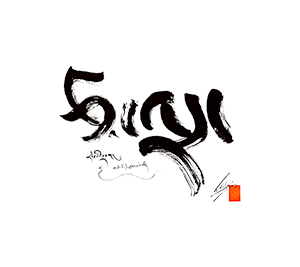'phags pa dgongs pa zab mo nges par 'grel pa'i mdo rgya cher 'grel pa
Wǒnch'ǔk's commentary to the Saṃdhinirmocanasūtra was extremely popular in the Chinese outpost of Dunhuang, where Chos grub (Ch. Facheng; c. 755–849) translated it into Tibetan during the reign of King Ral pa can (r. 815–838). Only nine of the ten rolls of the commentary are still extant in Chinese; the full text is available only in its Tibetan translation, which the Tibetans know as the "Great Chinese Commentary" (Rgya nag gi 'grel chen) even though it was written by a Korean. (Source: "Wǒnch'ǔk." In The Princeton Dictionary of Buddhism, 996–97. Princeton University Press, 2014. http://www.jstor.org/stable/j.ctt46n41q.27.)
From ancient times, the origin of "tathāgata", which has been usually translated as 如 來 (one who comes thus), is not unknown. This has been used as the title of Buddha, chiefly in Buddhism from the start.
Now, I will consider the meaning of "tathāgata" in the Abhisamayālaṃkārālokā Prajñāpāramitā-vyākhyā of Haribhadra (ed. by Wogihara) (W.). This includes the Aṣṭasāhasrikā-Prajñāpāramitā-sūtra (As.), Maitreya's Abhisamayālaṃkāraśāstra-kārikā (A.) which is a summary of the Pañcaviṃśatisāhasrikā-Prajñāpāramitā-sūtra (P.), and Haribhadra's commentary which is based on the P. and the As. Accordingly at first, I point out sentences of "tathāgata", which I think as the etymological explanations, and then survey the character of it. (Mano, "'Tathāgata' in Haribhadra's Commentary," 22)
The term ' ārambaṇa ' is one of the technical terms unique to Buddhism. Being equivalent to Pali ' ārammaṇa ' and Cl. Skt. ' ālambana ' it is usually used in the sense of 'basis of cognition' or 'sense-object', e.g. rūpa as ārambaṇa of cakṣurvijñāna, or dharma as that of manovijñāna. The usual equivalent to this term in Tibetan and Chinese language is ' dmigs pa ' and '所 縁', respectively.
What I am going to examine here is whether or not the same meaning mentioned above can be applied to this term used in the Ratnagotravibhāga (RGV), I, 9.
Read more here . . .
Then which text does he depend on to establish his original idea? As the Ratnagotravibhāga is cited most frequently in his bDen gnyis gsal ba'i nyi ma"`UNIQ--ref-00000003-QINU`"', it seems to be the most important text in his great Madhyamaka. I consider his commentary on the Ratnagotravibhāga"`UNIQ--ref-00000004-QINU`"' attributed to Maitreya here'"`UNIQ--ref-00000005-QINU`"'. (Mochizuki, introduction, 111)
. . . We may conclude the characteristics of the TG [tathāgatagarbha] theory in this sūtra in the following way.
1) The biggest contribution of the MPS [Mahāparinirvāṇa-sūtra] to the history of the TG theory is the establishment of the concept of buddhadhātu as explaining the nature of tathāgatagarbha. This dhātu concept as showing the essence or nature common to sattvas and the Tathāgata seems to be introduced by the AAN [Anūnatvāpūrṇatvanirdeśa], but the MPS, succeeding the AAN, utilized it in its full scope, in which are involved various other meanings of the term dhātu developed in Buddhism, such as relic of the Buddha, the 18 component elements, the 4 gross elements, sphere of the dharma, the essence of dharmas (e.g. the tathāgatakāya is not (consisting) of elements of collected materials (bsags paḥi khams), but of the essence of the dharma (chos kyi khams) (L. 110a1–2). It suggests that 'dharmakāya' is 'dharmadhātu-kāya' ), the word root, etc.
2) The most unique expression of this sūtra with respect to the TG is the ātman, which is regarded as a sort of taboo in Buddhism*. Connotation of this term in the text is completely identical with dhātu.
3) Inspite of the use of such an abstract concept, the MPS is far from systematization of the theory, in comparison with the AAN and the ŚMS [Śrītmalasūtra]. Especially the relationship between tathāgatagarbha and dharmakāya, problem of the pure mind and the defilements, etc. are not discussed explicitly as in the SMS. In this respect, I hesitate a bit to suppose the date of the MPS as coming after the ŚMS.
4) Inspite of frequent references to the icchantika, the term agotra is not used. In general, the gotra concept is lacking in the MPS. This point is common to the AAN, and the ŚMS. (Takasaki, section 6, 9–10)
Read more here . . .The point now I am going to express here is the discovery of the use of a compound noun ' tathāgata-gotra-saṃbhava ' in the Ratnagotravibhāga (Uttaratantra), which seems to be the Sanskrit original for '如來性起', one of the important terms in the philosophy of the Hua-yen (華嚴) Sect of Chinese Buddhism, but is actually not found in the Avataṃsaka, the basic scripture for that sect. (Takasaki, para. 1, 48)
This Text on Adarsha - If it doesn't load here, refresh your browser.
The wikipage input value is empty (e.g. <code>, [[]]</code>) and therefore it cannot be used as a name or as part of a query condition.

